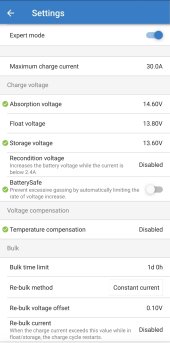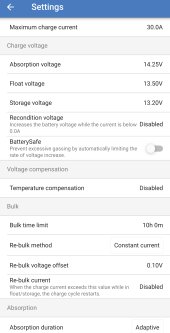Moderate term lurker here just signed up.
I have been closely following the tech side of lithium batteries since the early days and never determined they were worth the cost penalty and downsides vs AGM. The price thing has mostly relieved itself and my 440ah of Lifeline AGMs are getting near aging out so I decided to put in a bank of SOK 206ahX3 12v batteries to test and see if they are worth the close to 50% cost difference to us in our 07 Roadtrek 190 RV. We have 300 watts of solar on a Blue Sky controller with Pro remote so it can charge to tail amps. Shore charger is a 100 amp Magnum MS2000 with ARC-50 remote which will also charge to tail amps and do full cutoff/rebulk charging with no float. Alternator charging is from 530 amps of dual alternators that can give 200 amps continuous and 300 amps for about 20 minutes before getting to hot. I have a dash ammeter off the batteries to see tail amps and can lock the remote regulator into absorption for constant output. All three have temp compensation turned off for lithium. The three batteries can handle 120amps total at recommended rate and 150 or 210amps depending on who you believe. I have the Bluetooth so I can see individual cells on each battery.
The recommendations from SOK say to charge to 14.4-14.6v and hold 10 minutes to activate and give time to the auto balancing they use.
The problem in deciding is because there is lots of information and tech papers recently saying charging to a lower voltage like 13.8v is better than higher as the higher voltage shortens life. Some say go to 13.8v and cutoff and some say hold until a low amperage like 1%C is reached.
My guess is that the lower voltage is better but then you lose the auto balancing initiation which is probably needed, but maybe not on every cycle. I have tested the charge to 13.8v and hold until 1%C and the batteries got to a nice 90-95% SOC so decent headspace, where if I shut off immediately in was closer to 85%. At 14.6v and immediate shutoff it about the same 90-95% and with the hold time gets into the headspace too far it appears.
If the 13.8v is the better of the two I think the obvious solution was to put active balancers on each of the batteries, with a common shutoff for the balancers, if I find the balance is going off after some period of time/cycles that I would need to test for. I have found no real testing on this issue to this point so flying kind of blind.
Anybody got opinions or experience the this type of quandary?
I have been closely following the tech side of lithium batteries since the early days and never determined they were worth the cost penalty and downsides vs AGM. The price thing has mostly relieved itself and my 440ah of Lifeline AGMs are getting near aging out so I decided to put in a bank of SOK 206ahX3 12v batteries to test and see if they are worth the close to 50% cost difference to us in our 07 Roadtrek 190 RV. We have 300 watts of solar on a Blue Sky controller with Pro remote so it can charge to tail amps. Shore charger is a 100 amp Magnum MS2000 with ARC-50 remote which will also charge to tail amps and do full cutoff/rebulk charging with no float. Alternator charging is from 530 amps of dual alternators that can give 200 amps continuous and 300 amps for about 20 minutes before getting to hot. I have a dash ammeter off the batteries to see tail amps and can lock the remote regulator into absorption for constant output. All three have temp compensation turned off for lithium. The three batteries can handle 120amps total at recommended rate and 150 or 210amps depending on who you believe. I have the Bluetooth so I can see individual cells on each battery.
The recommendations from SOK say to charge to 14.4-14.6v and hold 10 minutes to activate and give time to the auto balancing they use.
The problem in deciding is because there is lots of information and tech papers recently saying charging to a lower voltage like 13.8v is better than higher as the higher voltage shortens life. Some say go to 13.8v and cutoff and some say hold until a low amperage like 1%C is reached.
My guess is that the lower voltage is better but then you lose the auto balancing initiation which is probably needed, but maybe not on every cycle. I have tested the charge to 13.8v and hold until 1%C and the batteries got to a nice 90-95% SOC so decent headspace, where if I shut off immediately in was closer to 85%. At 14.6v and immediate shutoff it about the same 90-95% and with the hold time gets into the headspace too far it appears.
If the 13.8v is the better of the two I think the obvious solution was to put active balancers on each of the batteries, with a common shutoff for the balancers, if I find the balance is going off after some period of time/cycles that I would need to test for. I have found no real testing on this issue to this point so flying kind of blind.
Anybody got opinions or experience the this type of quandary?




